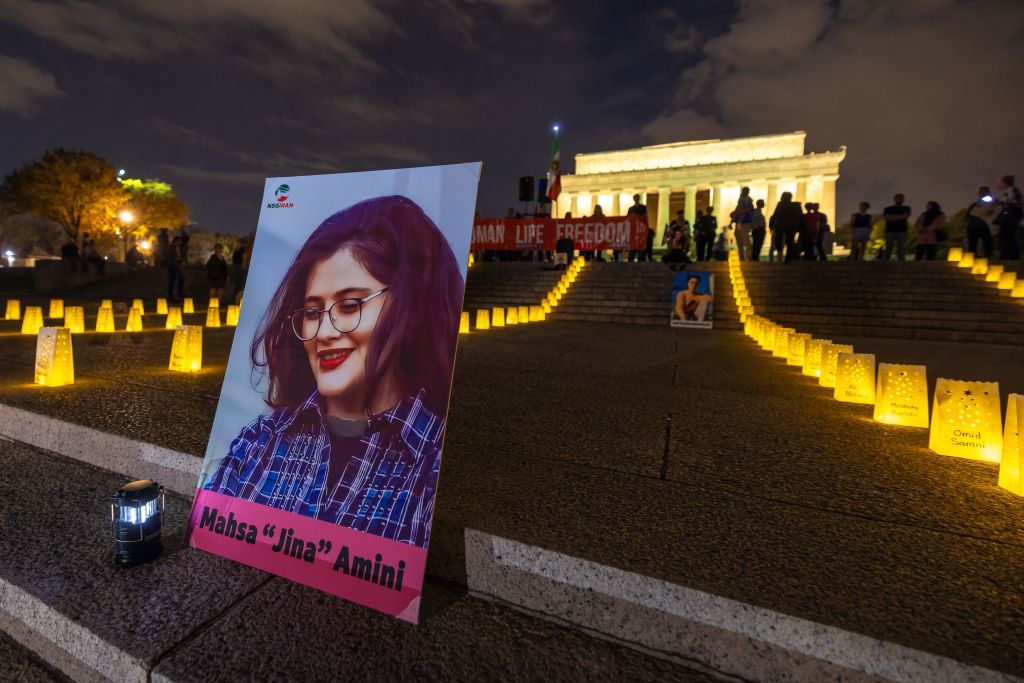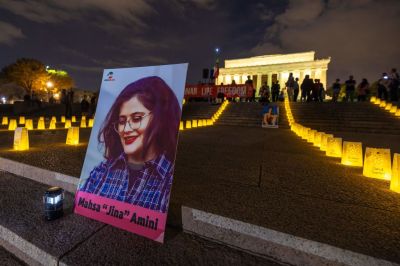Sarina Esmailzadeh was 16 years old when members of Iran’s security forces beat her to death in 2022. Her crime? Protesting the murder of Mahsa Amini, who had suffered a similar fate at the hands of Iran’s morality police for improperly wearing her hijab just a week prior.
A gifted student at a local high school in her hometown of Karaj, Esmailzadeh was deeply conscious of the basic freedoms denied her by the Iranian regime, often lamenting her anxieties about the future on her YouTube channel. “When it comes to freedom, our discussion gets dark. Because freedom is something that so many Iranian families have deprived their daughters of” she says in a vlog from May 2022. “Human beings naturally always look at those with the better conditions and want to get there … Why should my life be so different from theirs? Just because I was born in Iran?” Indeed, any number of innocent activities she documented across her videos—singing along to Western music, wearing her hair down, hanging out with male friends—would be subject to intense scrutiny under the Islamic Republic. “This is what bothers me. This is the freedom that is a dream in the heart of us youth.”
Esmailzadeh’s dream for a life of freedom—and that of countless other Iranians—is at the heart of Arash Azizi’s What Iranians Want, the first major written work on the 2022-2023 Women, Life, Freedom protest movement. The book is less a wholesale discussion of the uprisings sparked by Mahsa Amini’s death in September 2022 than it is a critical examination of the different social, political, and civic rights movements—dating back to the rise of the Islamic Republic in 1979—that provided the foundations upon which the current movement is built.
The courage of Iranians today, Azizi writes, is made possible by the “thousands of small acts of resistance,” predominantly by young women, which came before them. The book begins with the anti-compulsory hijab protests emanating from the early days of Ayatollah Ruhollah Khomeini’s rule, and with each subsequent chapter explores a different fight—for labor rights, refugee rights, freedom of expression, freedom of religion—and the work of ordinary Iranians who championed them.
Azizi’s book comes at a particularly volatile time in Iran’s foreign policy. Since Hamas’ October 7 attacks on Israel, the Iranian regime has sought to capitalize on the war in Gaza by supporting proxy attacks against U.S. forces in Iraq and Syria, while the Yemen-based Houthi movement continues to endanger freedom of navigation in the Red Sea. Iran has also gained an influential bloc of allies through its growing partnerships with China and Russia, recently providing Russian President Vladimir Putin with ballistic missiles to help aid and abet his war against Ukraine.
But for Azizi, Iran’s malign activities only pervert the world’s understanding of the Iranian people. “This is not the full story,” he cautions. Indeed, What Iranians Want wades through the heavy dust of international politics to “provide a window into the aspirations of Iranians”—often overlooked by Western observers—that are completely antithetical to those of their government.
Azizi shares the bravery of people like Mansoor Osanloo, who faced multiple jail sentences for advocating on behalf of worker unions; Mahlaqa Mallah, whose house was burned down for speaking out in support of female education; and Seyed Emami, who was found dead in connection to his wildlife conservation efforts. It would be difficult for anyone to come away from this book without a more nuanced understanding of the Iranian people’s deep disillusionment with the regime, as well as the breadth and depth of their (often life-threatening) opposition to being remade in its image. “I want to make the voices of Iranians heard loud and clear throughout a world that so often ignores them,” Azizi writes in his foreword to the reader.
Even so, the book sometimes errs on offering more information than needed to make its point. Many names come and go throughout each chapter, making it hard to keep track of them, or at least remember the important ones when they appear. Azizi clearly loves Iran and its people, but he overindulges on certain details at times. (He spends an entire page describing efforts to get Pirouz, a Persian cheetah cub who died in captivity, impregnated, for instance.) More important, however, is Azizi’s broader point about the regime’s efforts to wipe away all traces of dissent: “Bits and pieces, fragments—this is all we had to go on to piece a picture together of their lives, their personalities, their aspirations. The regime wasn’t keen on us knowing more than that, running a massive campaign of misinformation.”
Even so, many prominent voices from the Women, Life, Freedom movement have publicly defied the regime—including Masih Alinejad, whom Azizi briefly mentions—and the book may have been better served by offering fewer, more focused looks at their activism. Indeed, it’s only in the final chapter, devoted entirely to Esmailzadeh’s story, that the answer to the book’s penultimate question—what do Iranians want?—manifests itself most clearly and remarkably to the reader.
But who exactly is the reader? It’s no surprise that Azizi—a historian at Clemson University and native Iranian who has closely followed the country’s domestic politics—makes many detailed references to Iran’s political figures and institutions. That’s certainly appropriate for readers with a considerable degree of knowledge about Iran, but such detail may not mean much to those for whom this book serves as a first foray into Iranian culture and society. What is the difference between a hardliner and reformist? What are the competing power dynamics at play between the president, supreme leader, and Islamic Revolutionary Guard Corps? And what does all this mean in the context of the current movement? How can the Iranian people move from protest to real, tangible change? Such a top-down political history is beyond the scope of this book, as Azizi says himself. And yet it can be hard to fully paint an accurate portrait of the movement—its setbacks, its successes, its future potential—without understanding how these domestic factors dictate the country’s outlook.
Still, Azizi’s book is an important outlet for the many Iranian voices calling for the end of the Islamic Republic as they know it, particularly as the regime proves itself to be the most destabilizing threat to the Middle East while U.S. policy fails to rein in its worst impulses. What will ultimately come of the ongoing strife in Iran is still anyone’s guess, but Azizi concludes with two prognoses: The Women, Life, and Freedom movement either “extinguishes too soon to secure lasting change” or testifies to “the beginnings of a thorough transformation.”
Perhaps the biggest takeaway from What Iranians Want is that the door to democracy in Iran may not be through back channel negotiations, targeted strikes, or even direct military intervention—it’s through the Iranian people themselves. But as the regime’s violent crackdowns have proven, demonstrations alone are inadequate. What Iranians need now is support creating the conditions that turn their mass movement into a real revolution.






Please note that we at The Dispatch hold ourselves, our work, and our commenters to a higher standard than other places on the internet. We welcome comments that foster genuine debate or discussion—including comments critical of us or our work—but responses that include ad hominem attacks on fellow Dispatch members or are intended to stoke fear and anger may be moderated.
With your membership, you only have the ability to comment on The Morning Dispatch articles. Consider upgrading to join the conversation everywhere.